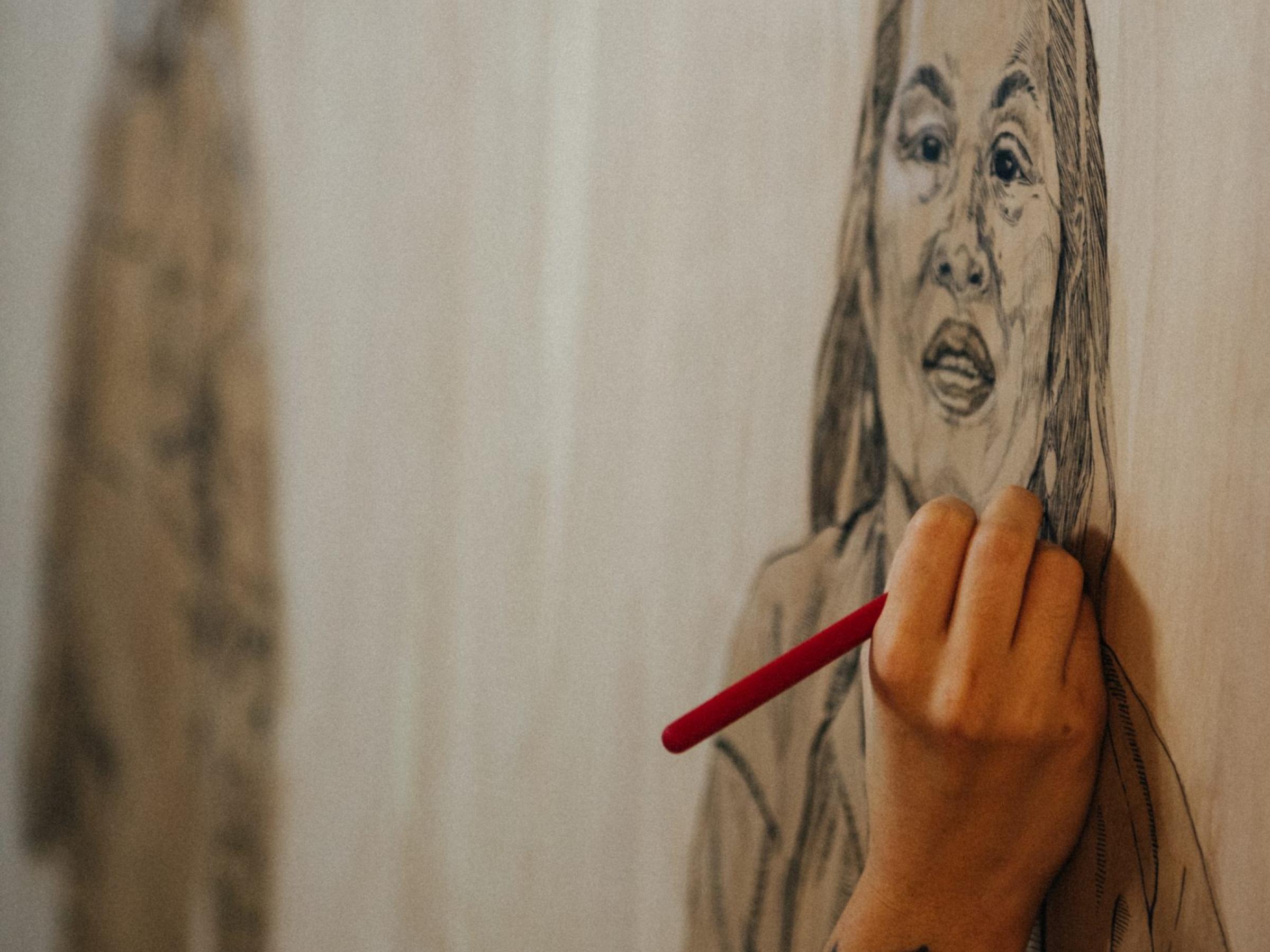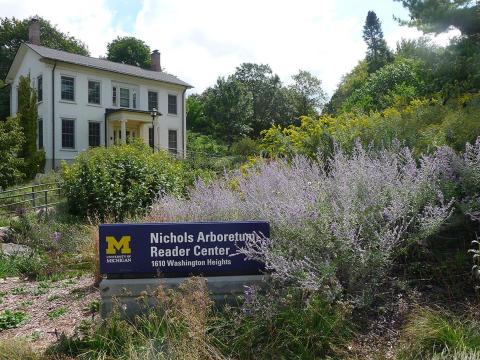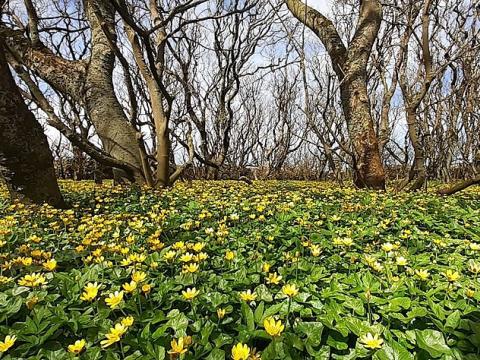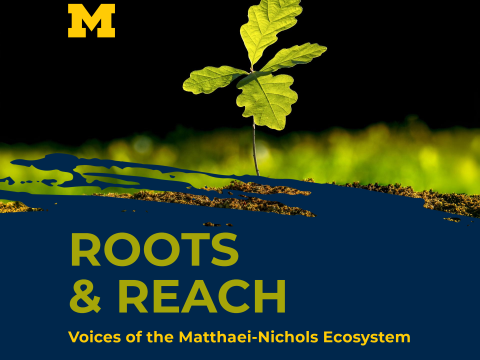Matthaei Botanical Gardens will feature two linked exhibitions created by undergraduate student and former MBGNA DEIJA researcher Mahalina Dimacali. These exhibitions, Rooting Reciprocity and Kina n’da-nowendaaganag / All My Relations, are the culmination of 3 years of research and engaged scholarship to create a framework for botanical gardens rooted in community needs and co-liberatory practice.
Mahalina Dimacali is a community and cultural organizer whose research explores the intersections of critical museum studies, Indigenous studies, and ethnobotany. Since 2017, her focus has been on how museums can affirm or deny relationships with the water, land, and all beings within. Her work is rooted in the belief that everyone should have access to culturally relevant spaces to foster these relationships. While she has worked in various fields within museums (education, public programs, research, and curation), her work is informed by community relationships and held accountable by her familial teachings.Mahalina is the anak/child of Annabelle apo/grandchild of Feliza. She identifies as a queer, multiracial, descendant of the mountains, waters, and generations of healers in the Philippines. She is currently completing her undergraduate degree at the University of Michigan in the Program in the Environment with a minor in Museum Studies in the unceded homelands of the Anishinaabek (Odawa, Ojibwe, Bodewademi) and Wyandot.
Your upcoming displays, “Rooting Reciprocity” and “Kina n’da-nowendaaganag / All My Relations,” seem to merge art, culture, and environmental education. What inspired you to create these exhibitions?
My nanay (mom) Annabelle and her mother, my lola Feliza, are the reasons for everything I do. I am grateful to have been raised in a home and culture where there is no separation between the three (art, culture, and environment), so it was a natural response to express in this way.
The garden has always been a place of learning how to be in a relationship for me. However, being in the diaspora in a completely different climate from my motherland (the Philippines) maintaining connection to cultural relationships that are based on the land, especially the plants therein, is difficult. There is only so much you can do with asking in the past tense. The opportunity to directly interact with plant relatives is an entirely different experience in learning and teaching. It becomes active. Visiting botanical gardens, specifically MBGNA, when I was younger was integral to my understanding of the difference. It was within their conservatory that I learned stories from my nanay that wouldn’t have occurred without the presence of our plant relatives and the memories they keep for her, and by extension, our culture.
Botanical gardens, and all public land-based learning spaces, should be critical places for activating and maintaining connection. Especially for individuals and communities who do not have equal access to land otherwise. However, if only a western understanding is prioritized, the opportunity for relationships can be limited. Western botany and botanical gardens as they are reinforce “nature” as an intentional disconnect from the human experience. In this way nature becomes something to go to, instead of something we are inherently a part of. They rely on myths of neutrality and expertise to legitimize themselves, when there is a world of understandings beyond their purview.
For the past three years, I have been engaging in community conversation to create practices for botanical gardens that better reflect the needs and knowledge systems of the communities they serve. My concern and priority is that these conversations do not start and die within the academy. I have worked in museums in differing capacities for many years and what I have noticed is that they love to discuss “decolonization” and “DEI” within the confines of their inner circle. However, when it comes to engaging in genuine re-learning, they rarely do it publicly. This is important because, without public conversation, museums are not held accountable to change. These displays are an invitation for the public to be a part of the conversation. The prioritization of community voice, knowing their names, and ability to look every person in the eye is a reflection of what I learned during one of these community conversations. A mentor shared with me that care comes from connection. That is what I’m trying to do with these displays, create opportunities for connection.
How might these displays reshape the narrative and representation of Indigenous cultures within botanical gardens, specifically in challenging colonial knowledge systems?
If we’re being honest, these displays won’t reshape anything. I think it is important that these installations aren’t conflated with a solution or justice. Justice is for Indigenous communities to define personally for themselves, not by museums or myself. Especially on occupied land, community-defined representation is not equal to land return. However, it is a step toward making relationships, which is critical for meaningful change moving forward.
What I can hope for is when people see context beyond a scientific binomial in these spaces, they consider how limited and singular of a narrative is offered within western botanical gardens. There is so much potential to create more if communities are able to contribute in a way that safely and respectfully honors their knowledge. Western botanical gardens and museums as a whole are still reckoning with the reality that they are not spaces that are safe for everyone. They are places for “experts” who have been created and defined by academic systems museums legitimize. The separation of land and people, land and relationship, is rooted in colonial systems. This impacts everyone, not only Indigenous communities. For people who are a part of the communities that are represented within any of the art here or have relationships similar to those being shared, I hope that they feel loved and know that their ways of knowing the world are celebrated and valid. For those who feel that they don’t have relationships with the land, I hope they feel encouraged to consider why that might be and how land-based learning spaces and fields such as botany have contributed to that. We are complicit in colonial conceptualizations of land when we deny the ability for relationships beyond “academic” definition within ourselves.
For museums, I hope that they see that museum practice should be shifting toward using our positions to support communities in sharing their own stories instead of making decisions and narratives for them. That it is not only possible but infinitely more beautiful and meaningful this way.
How did you collaborate with the communities featured in the exhibit, and what challenges did you encounter in portraying these relationships authentically?
I am grateful and lucky that every step of this journey has been done with community. The projects themselves are a direct reflection of the generous care, consent, and support individuals have had in sharing their desires and frustrations for these spaces. The portraits for Rooting Reciprocity are just one embodiment of this collaboration: the wood is stained with black walnut dye foraged for and created by my friends Kaden Brouwer and John Robinson, the paintings were done by Zoi Crampton and myself, and the photo references we used were provided by the representatives or their family members and friends. While the accompanying sign on the plant relative of their choosing and their biographies were written entirely by them. As I answer these questions, my partner Isaac Reimer and his brother Evan are preparing to cut out the portraits. Nothing has been done alone! While realistically, this is not an exhaustive representation of communities, the prioritization is using this opportunity to support their voices instead of my own.
The biggest challenge is distance and time. If this project wasn’t for a senior thesis, there would be many years of relationship-building before an ask was made of the representatives. For reference, in museum studies, we learn that exhibitions often take a minimum of two years of preparation. We started formally organizing this work in the summer of 2023! However, these relationships will continue far beyond this project. They are a lifelong commitment for me and I hope MBGNA, too. It is only the beginning.




